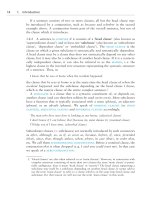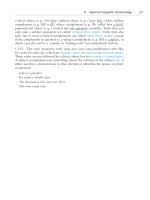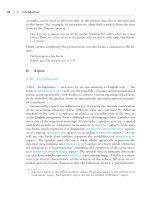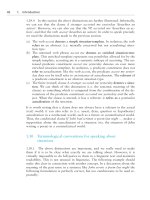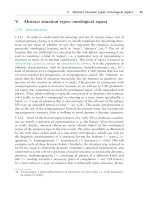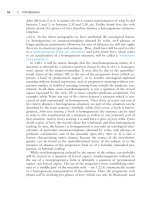The grammar of the english verb phrase part 96 pptx
Bạn đang xem bản rút gọn của tài liệu. Xem và tải ngay bản đầy đủ của tài liệu tại đây (97.98 KB, 7 trang )
658 13. Adverbial
when
-clauses and the use of tenses
and because, when the situation time of the head clause is T-anterior to the
contained orientation time of the head clause, it is often more natural to use
by the time that than to use when. Another thing worth noting is that in
configurations 1Ϫ3, the when-clause is used as a situation-time adverbial. In
configurations 4Ϫ9, it is used as an orientation-time adverbial.
6
13.8.2 In the above examples, a form involving be going to is used in the
when-clause whenever the situation time of the when-clause is to be repre-
sented as T-posterior to the contained orientation time of the when-clause (viz.
in configurations 3, 8 and 9). The reason for this is that we cannot normally
use will or would to represent this T-posteriority relation. We must use a form
of be going to, or of a similar ‘futurish form’ (see 7.3) like be about to, be on
the point of, etc. The same restriction applies to the head clause if the situation
time of the head clause is to be represented as T-posterior to the contained
orientation time of the head clause (viz. in configurations 5, 7 and 9). This
means that it is a general rule that a tense form expressing T-posteriority in one
of the above nine configurations must involve an auxiliary with ‘prospective’
(Jespersen 1932: 361Ϫ2) meaning, i. e. an auxiliary which is not so much used
to make a prediction as to represent a future situation as anticipated, i. e. as
having its roots in the present (see 7.3.2).
7
The reason for this restriction is
that in the relevant configurations it is not the situation time of the clause
expressing T-posteriority (i. e. the situation time represented as T-posterior)
that is the ‘contained orientation time’ contained in the common Adv-time but
rather the time to which the situation time is represented as T-posterior, i. e.
the time when the posterior situation is anticipated. This means that the poste-
riority is always of the prospective type. When a form with prospective mean-
ing is used, an Adv-time can include the time of anticipation rather than the
anticipated situation time. The same is not normally possible when will or
would is used. Compare:
[I told her I would be in Hamburg in the first week of May and] she told me she
{would / was going to} be in Prague then.
She often felt sick because she {was then going to have /*would then have} a baby.
6. The latter six configurations could be adapted in such a way that the common Adv-time
contains not only the contained orientation time of the head clause to which the situation
time of the head clause is T-related but also the situation time of the head clause itself.
In that case the when-clause would be used as ‘multiple-orientation-time adverbial’ (see
2.26). This possibility need not be explicitly treated here because the use of tenses in the
six resulting configurations is the same as in configurations 4Ϫ9.
7. Because of its prospective meaning, be going to differs from will in that it presupposes
that all the necessary conditions for the actualization of the future situation are satisfied
(see 7.12.1).
III. Configurations of temporal relations 659
In the first example, then specifies the situation time of the T-posterior situa-
tion; this is possible irrespective of whether the verb form has prospective
meaning or not. In the second example, by contrast, then specifies (contains)
the orientation time to which the situation time is T-posterior. This configura-
tion requires a prospective verb form. Since a when-clause specifies an Adv-
time in the same way as then does, the same is true in configurations with a
when-clause when the contained orientation time of the when-clause is the
orientation time to which the relevant situation time is T-posterior.
13.8.3 There is a similar restriction on the tense forms expressing T-anteri-
ority. In those configurations in which the situation time of the when-clause is
represented as T-anterior to the contained orientation time of the when-clause,
the when-clause has to use a perfect tense form. This requirement is not imme-
diately clear when we consider sentences referring to the past (since the past
perfect is the one tense to be used to express T-anteriority to a past orientation
time), but it becomes evident when the head clause refers to the post-present:
If we do it this way, the police will never find out that it {was done / has been done}.
John will arrive when the others {have left /*left}.
Whereas in the first example both the past tense and the present perfect can
be used to represent the situation time of the that-clause as T-anterior to the
situation time of the head clause, only the present perfect can be used in the
when-clause of the second sentence. The reason is that if the when-clause ex-
presses T-anteriority, the time indicated by at which in the paraphrase at the
time at which is not the time of the when-clause situation itself (i. e. the situa-
tion time of the when-clause) but a time when it is the case that the when-
clause situation has already actualized. In order to express this idea of ‘time at
which the when-clause situation has actualized’ we obviously need a perfect
tense form.
660 13. Adverbial
when
-clauses and the use of tenses
IV. Direct and indirect binding in
when
-clauses
13.9 Definitions of direct and indirect binding in when-
clauses
As far as adverbial when-clauses are concerned, direct binding (i. e. the unmarked way
for the situation time of the when-clause to be bound) means that the situation time
of the when-clause is bound by the contained orientation time of the when-clause. Any
other form of binding is an instance of indirect binding.
As noted in 9.28.1, the situation time of a subclause is bound ‘directly’ if it is
bound by the situation time of its head clause, and is bound ‘indirectly’ if it is
bound by an orientation time represented in a clause higher than the head
clause. The following sentences illustrate the two possibilities:
He promised he would sign any papers that were put before him.
He promised he would speak to Tom, who would no doubt be able to help me.
In the first example, both would sign and were put effect direct binding:in
both cases the relevant situation time is bound by the situation time of its own
head clause. In the second example, would speak is also bound directly, but
would be able is an instance of
indirect binding: the binding orientation time
is not the situation time of the head clause (he would speak to Tom) but rather
the situation time of the matrix clause (he promised).
In the case of adverbial when-clauses, direct binding has to be defined
slightly differently, since in the nine configurations referred to in 13.7 the situa-
tion time of the when-clause is never directly T-related to the situation time of
the head clause but is always bound by the contained orientation time of the
when-clause. As far as adverbial when-clauses are concerned, direct binding
(i. e. the unmarked way for the situation time of the when-clause to be bound)
means that the situation time of the when-clause is bound by the contained
orientation time of the when-clause. Any other form of binding is an instance
of indirect binding.
13.10 The use of indirect binding in when-clauses
Only when-clauses in the past perfect can effect indirect binding. They can do so under
strict conditions only.
IV. Direct and indirect binding in
when
-clauses 661
13.10.1 Because indirect binding represents the marked option, it is subject
to severe restrictions. In fact, there is only one form of indirect binding that is
quite common in when-clauses, viz. that illustrated by examples like the follow-
ing:
The house had been like this when he and Jean had first come here. (NMDT 68)
[He said] he had bought it when he had been going to get that salary increase [which
in fact he never got].
When he had turned 18 he had already outsmarted almost every commander in the
war games [and was still undefeated on the Balance Log in the training division].
(www)
When I had turned 13, I had already absorbed much of a foreign, American cul-
ture. (www)
In each of these examples, the when-clause situation is interpreted as W-simul-
taneous with the head clause situation. The unmarked way of expressing this
reading would be by the use of a relative past tense form in the when-clause,
i. e. by the realization of configuration 1 (in which the situation time of the
when-clause is bound directly, more specifically, represented as T-simultaneous
with the contained orientation time of the when-clause). The use of the past
perfect in the when-clause means that the situation time of the when-clause is
not bound by the contained orientation time of the when-clause but by the
same past orientation time as also binds the situation time of the head clause.
This form of indirect binding is represented by Figure 13.10. (Remember that
the wavy line does not represent a T-relation but indicates the relation of W-
simultaneity which is inferred in W-interpretation.)
t
0
x
. . . .
had been
x
x
x
had come
Figure 13.10. The temporal structure of The house had been like this when he and
Jean had first come here.
662 13. Adverbial
when
-clauses and the use of tenses
A when-clause can only be bound indirectly (by the use of the past perfect) if it used
as a situation-time adverbial, i. e. if the when-clause specifies the time of the head
clause situation itself, not another time to which the time of the head clause situation
is T-anterior.
13.10.2 It is typical of examples like the ones given in the previous subsection
that both the head clause and the when-clause use a past perfect (either a
regular past perfect or a form involving had been going to). It might therefore
seem as if the when-clause ‘copies’ the tense form of its head clause. However,
the use of the past perfect in the head clause is not a sufficient condition for
the use of the same tense in the when-clause. An additional condition is that
the when-clause must be used as a situation-time adverbial. If the when-clause
is used as an orientation-time adverbial, it cannot be bound indirectly. Compare:
The house had been dilapidated when he and Jean had first seen it.
He had already retired when he {was /*had been} sixty.
WhenI{saw /*had seen} you that day, we hadn’t met yet.
In all three examples the condition that the head clause must be in the past
perfect is satisfied. However, it is only in the first example that the when-clause
can be bound indirectly, because this is the only example in which the when-
clause is used as a situation-time adverbial (i. e. the contained orientation time
of the head clause is the situation time of the head clause). In the second and
third examples, the when-clause is used as an orientation-time adverbial: as
shown in Figure 13.11, the contained orientation time of the head clause is not
the situation time of the head clause but a time to which the situation time of
the head clause is T-anterior. Because of this, indirect binding is not allowed
in these examples.
In sum, as a rule, the use of a past perfect in the head clause is not a
sufficient condition for indirect binding (by means of the past perfect) in the
when-clause. There is the additional condition that the when-clause must be
used as a situation-time adverbial, i. e. that the when-clause specifies the time
of the head clause situation itself, not another time to which the time of the
head clause situation is T-anterior.
8
This is clear when we compare Figure
13.10 with Figure 13.11, which represents the temporal structure realized by
the when-clause and its head clause in He had already retired when he was
sixty.
8. Still, the use of the past perfect in the when-clause would be unusual in sentences like
the following, in which the verb of the when-clause is a pro-form: Afterwards I was glad
that I had left when I did.
IV. Direct and indirect binding in
when
-clauses 663
t
0
x
. . . .
x
x
had retired
x
was
Figure 13.11. The temporal structure of He says that he had already retired when he
was sixty.
13.10.3 This does not mean, however, that it is never possible for the two
clauses to use the past perfect if the when-clause is used as an orientation-time
adverbial. Consider the following:
[There was a little confusion as a friend asked me to buy a ticket for him, too, but]
when I had done so he had already reserved a ticket for himself. (www)
In this example, the when-clause is used as an orientation-time adverbial (speci-
fying a time prior to which the head clause situation has actualized). The situa-
tion time of the head clause is itself T-anterior to the central orientation time
of the past domain. (This is in keeping with the use of already.) Because the
when-clause is not used as a situation-time adverbial, the when-clause situation
is not interpreted as W-simultaneous with the head clause situation. This means
that there is no indirect binding. The temporal structure of this example is
shown in Figure 13.12.
Figure 13.12. The temporal structure of When I had done so he had already reserved
a ticket for himself.
664 13. Adverbial
when
-clauses and the use of tenses
This example, then, does not form an exception to the general rule that a
when-clause can only be bound indirectly (by the use of the past perfect) if it
is used as a situation-time adverbial. In this example the when-clause is used
as an orientation time adverbial, and there is direct binding. The when-clause
situation is interpreted (and represented) as anterior to the contained orienta-
tion time of the when-clause. This is unlike what happens in indirect binding,
where the situation time of the when-clause is interpreted as W-simultaneous
with the situation time of the head clause although it is not represented as
T-simultaneous with it (because it is represented as T-anterior to the central
orientation time of the domain).
13.10.4 In examples like the following, there seems to be ambiguity between
indirect binding (as represented in Fig. 13.10) and direct binding (as represented
in Fig. 13.12):
When he had been born, Mike had already chosen his name, [deciding to name him
after his father, who had inspired him to become a policeman in the first place.]
(www)
[“Forgive me! And Adieu to you Master Rin,” said John.] When John had departed,
the sun had already begun its decline. (www)
13.10.5 If a when-clause uses the past perfect for indirect binding, the context
has to make it clear that the situation time of the when-clause should be inter-
preted as W-simultaneous with the contained orientation time of the when-
clause, and hence with the situation time of the head clause. The past perfect
itself does not express this relation. If the form that effects indirect binding is
built with had been going to,asin
He said he had bought it when he had been going to get that salary increase [which
in fact he never got].
the situation time of the when-clause must be interpreted as posterior to the
contained orientation time of the when-clause (see Fig. 13.13). This time the
tense form does express this relation. The above sentence is an alternative to
the following, which shows direct binding:
He said he had bought it when he was going to get that salary increase [which in
fact he never got].
The difference between indirect binding (had been going to) and direct binding
(was going to) here is that only in the former case does the tense form express
a
complex T-relation (see 9.7) which combines posteriority and anteriority.
The binding time from which that T-relation starts is the situation time of said,
which means that there is indirect binding.
13.10.6 An interesting observation is that when the when-clause is bound
indirectly, the speaker sometimes deviates from the structure represented by



